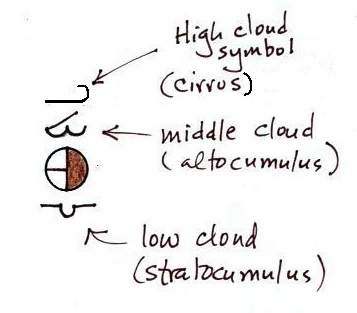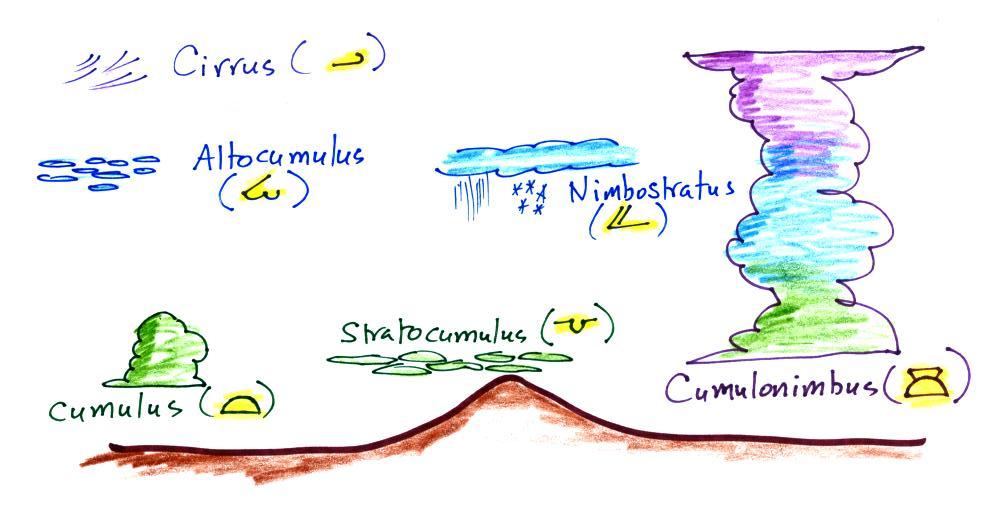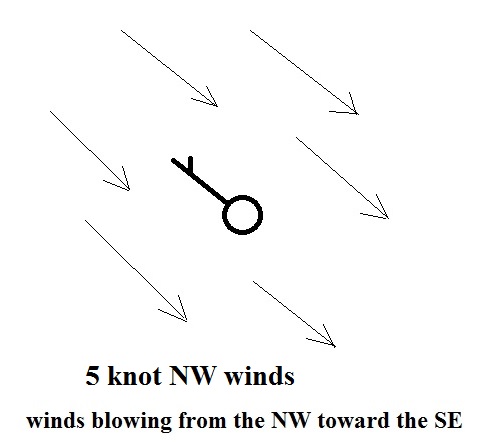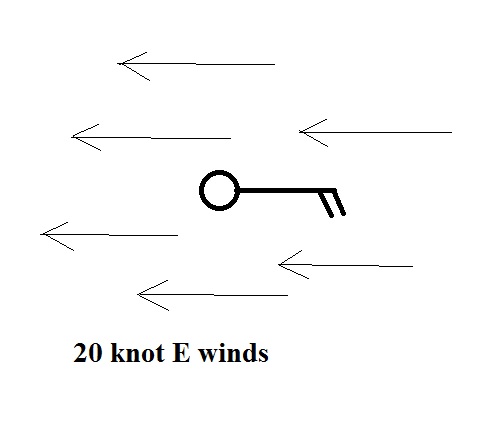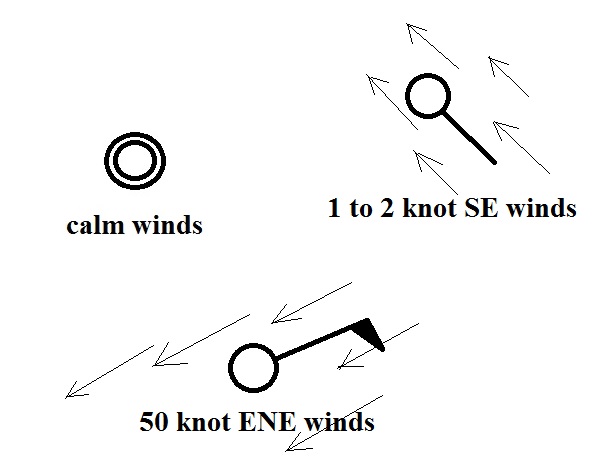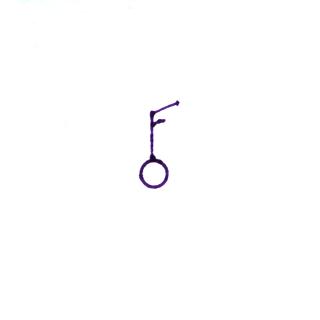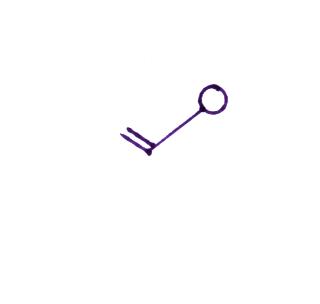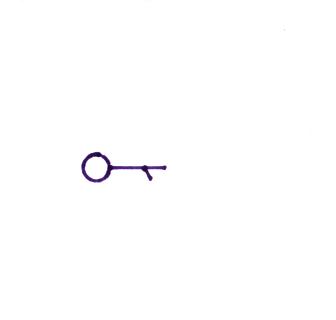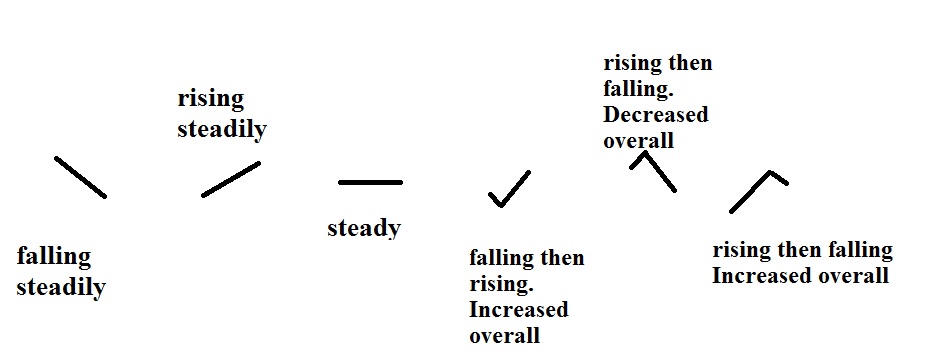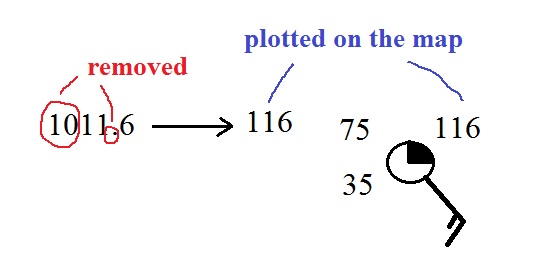Begin Quiz #2 Material
Monday, September 16
We'll be using page
37a, page 37b, page 38a, and page 38b from the
ClassNotes package
Surface weather maps
We
will
begin by learning how weather data are entered
onto surface weather maps.
Much of our
weather is produced by relatively large scale
(synoptic scale) weather systems - systems that
might cover several states or a significant
fraction of the continental US. To be able
to identify and locate these weather systems you
must first collect weather data (temperature,
pressure, wind direction and speed, dew point,
cloud cover, etc) from stations across the
country and plot the data on a map. The
large amount of data requires that the
information be plotted in a clear and compact
way. The station model notation is what
meteorologists use.
Station model notation

A small circle is plotted on the map at the
location where the weather measurements were made. The
circle can be filled in to indicate the amount of cloud
cover. Positions are reserved above and below the
center circle for special symbols that represent different
types of high, middle, and low altitude clouds. The
air temperature and dew point temperature are entered to the
upper left and lower left of the circle respectively.
A symbol indicating the current weather (if any) is plotted
to the left of the circle in between the temperature and the
dew point; there are close to 100 different weather symbols
that you can choose from. The pressure is plotted to
the upper right of the circle and the pressure change (that
has occurred over the past 3 hours I believe) is plotted to
the right of the circle.
Here's
an example of a surface map from the Dept. of
Hydrology and Atmospheric Science web page.
This is the 1 pm map from last Tuesday, Sep. 3
(Hurricane Dorian was moving away from the Bahamas
and up the Florida coast). I'll try to show
a current map in class. Maps like this are
available here.
The Arizona portion of the map is shown
below. The data for Tucson are circled and
blown up in the lower right part of the figure.

In
Tucson at 1 pm MST last Tuesday the temperature
was 98 F and the dew point temperature was 57
F. The winds were from the NW at 5 knots and
clear skies were being reported. The
pressure (corrected to sea level altitude) was
1008.7 mb (this is derived from the 087 value to
the upper right of the circle).
We'll work through this
material one step at a time (refer to page
37a in the ClassNotes).
Cloud cover and cloud type
Meterologists determine what
fraction of the sky is covered with clouds and note what types
of clouds are present.
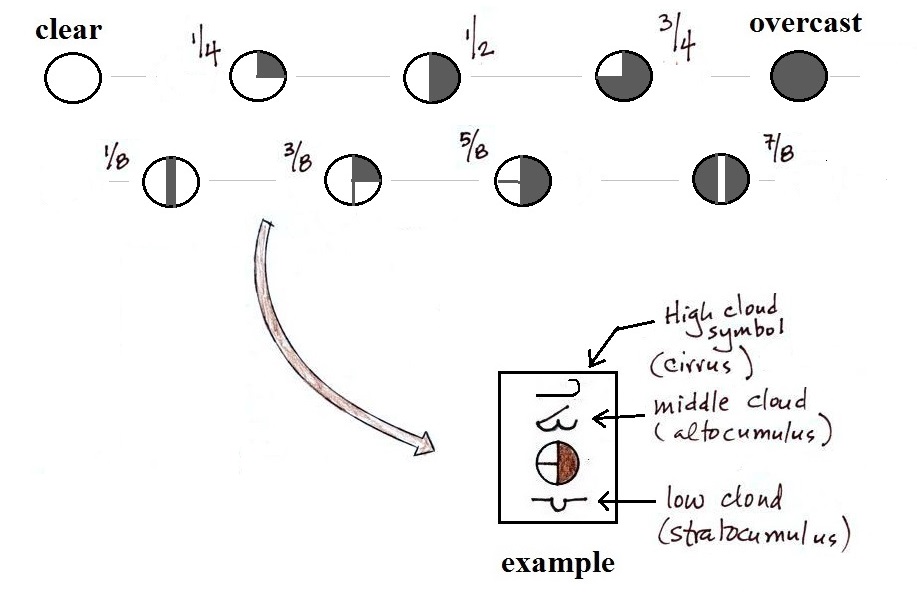
The center circle is filled in to indicate
the portion of the sky covered with clouds (to the nearest 1/8th
of the sky) using the code at the top of the figure (which I
think you can mostly figure out). 5/8ths of the sky is
covered with clouds in the example shown.
In addition to the amount of cloud coverage, the actual types
of clouds present (if any) can be important. Cloud types
can tell you something about the state of the atmosphere
(thunderstorms indicate unstable conditions, for example).
We'll learn to identify and name clouds later in the semester
and will just say that clouds are classified according to
altitude and appearance.
Positions are reserved above and
below the center circle for high, middle, and low altitude
cloud symbols. Six cloud types and their
symbols are sketched above. Purple represents
high altitude in this picture. Clouds found at high
altitude are composed entirely of ice crystals. Low
altitude clouds are green in the figure. They're
warmer than freezing and are composed of just water
droplets. The middle altitude clouds in blue are
surprising. They're composed of both ice
crystals and water droplets that have been cooled below
freezing but haven't frozen.
There are many more cloud symbols than shown here(click
here
for a more complete list of symbols together with photographs of
the different cloud types. You can click on any of the
cloud images to get a larger picture and additional examples of
each cloud type)
Air temperature and dew point temperature
The air temperature and dew point temperature are found to
the upper left and lower left of the center circle,
respectively. These are probably the easiest items to
read.
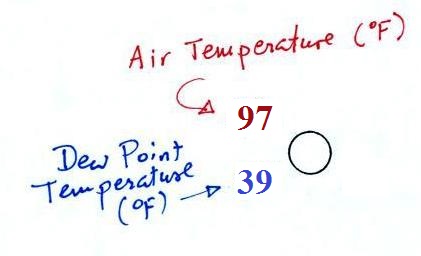
Dew point gives you an idea of the amount of
moisture (water vapor) in the air. The table
below reminds you that dew points range from the mid 20s to the
mid 40s during much of the year in Tucson. Dew points rise
into the upper 50s and 60s during the summer thunderstorm season
and the dew point.
Dew Point
Temperatures (F)
|
|
70s
|
common in many parts of the US in
the summer
|
50s & 60s
|
summer T-storm season in Arizona
(summer monsoon)
|
20s, 30s, 40s
|
most of the year in Arizona
|
10s or below
|
very dry conditions
|
Wind direction and wind speed
We'll consider winds next. Wind direction
and wind speed are plotted(page
37b in the ClassNotes)
A straight line extending
out from the center circle shows the wind direction. Meteorologists
always give the direction the wind is coming from. In the example above
the winds (the finely drawn arrows) are blowing from the NW
toward the SE at a speed of 5 knots. A meteorologist would
call these northwesterly winds.
Small "barbs" at the end of the straight
line give the wind speed in knots. Each long barb is worth
10 knots, the short barb is 5 knots. The wind speed in
this case is 5 knots. If there's just a short barb it's
positioned in from the end of the longer line (so that it
wouldn't be mistaken for a 10 knot barb).
Knots are nautical miles per hour. One nautical mile
per hour is 1.15 statute miles per hour. We won't worry
about the distinction in this class, we will just consider one
knot to be the same as one mile per hour.
Winds blowing from the east at 20 knots.
A few more examples of wind directions
(provided the wind is blowing) and wind speeds. Note how
calm winds are indicated. Note also how 50 knot winds are
indicated.
Here are four more examples to practice
with. Determine the wind direction and wind speed in each
case. Click here
for
the answers.
Weather (that
may be occurring when the observations were made)
And maybe the most interesting part.
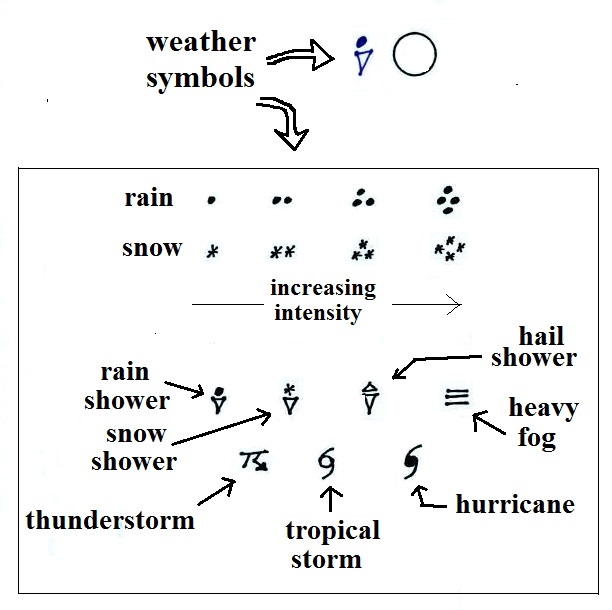
A symbol representing the weather that is
currently occurring is plotted to the left of the center circle
(in between the temperature and the dew point). Some of
the common weather symbols are shown. There are about 100
different
weather symbols that you can choose from.
Pressure
The pressure data is usually the most confusing and most
difficult data to decode (page
38a in the ClassNotes)
The sea level pressure is shown above and to the right of the
center circle. Decoding this data is a little "trickier"
because some information is missing. That is done to save
room on the surface map. We'll look at this in more
detail momentarily.
Pressure change data (how the pressure has changed
during the preceding 3 hours) is shown to the right of the
center circle. Don't worry much about this now, but it may
come up next week.
The figures below show the pressure tendency, the symbol
following the pressure change value. This is a visual
record of how pressure has been changing during the past 3
hours.
Again this is something we might use when trying to
locate warm and cold fronts on a surface weather map.
Don't worry too much about it now.
Sea level pressure
Before being plotted on a surface map, pressure
data must be corrected for altitude.
Some typical rates of pressure change are shown below
Meteorologists hope to map out small horizontal pressure
differences on a surface map. It is the small
horizontal differences in pressure that cause the wind to
blow and create storms. If corrections for altitude
were not made, the large vertical changes in pressure caused
by altitude would dominate and would completely hide the
horizontal pressure variations.
Here's an example of what would be done with a station
pressure measurement made in Tucson.
In the example above, a station
pressure value of 927.3 mb was measured in Tucson. Since
Tucson is about 750 meters above sea level, a 75 mb correction is added
to the station pressure (1 mb for every 10 meters of
altitude). The sea level pressure estimate for Tucson is
927.3 + 75 = 1002.3 mb.
This
sea level pressure estimate is the number that gets plotted on
the surface weather map. And actually there is one
additional complication:
To save space only a portion of the full sea level pressure
value is plotted on the map. When reading a weather map
you need to remember to replace the missing 9 or 10 and the
decimal point.
Do you need to remember all
the details above and be able to calculate the exact
correction needed? No. You should
remember that a correction for altitude is
needed. And the correction needs to be added to the
station pressure. I.e. the sea-level pressure is
higher than the station pressure.
Coding and decoding pressure
Here are some examples of coding and decoding the pressure
data (page
38b in the ClassNotes)
First of all we'll take some sea level
pressure values and show what needs to be done before the
data is plotted on the surface weather
map. Here are more examples than we did in
class.
Sea level pressures generally fall between 950 mb and 1050
mb. The values always start with a 9 or a 10. To
save room, the leading 9 or 10 on the sea level pressure
value and the decimal point are removed before plotting the
data on the map. For example the 10 and the decimal pt in 1011.6 mb would be
removed; 116 would be plotted on the weather map (to the
upper right of the center circle). Some additional
examples are shown below.
Here are 3 more examples for you to try
(you'll find the answers at the end of this
section): 1035.6 mb, 990.1 mb, 1000 mb.
You'll mostly have to go the other direction. I.e.
read the 3 digits of pressure data off a map and figure out
what the sea level pressure actually was. This is
illustrated below.
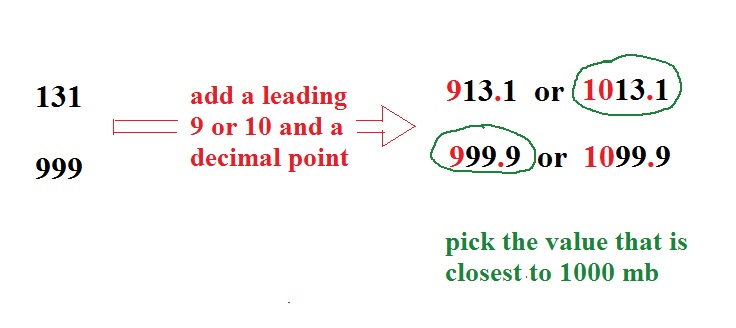
When reading pressure values off a map you must remember to add
a 9 or 10 and a decimal point. For example 131
could be either 913.1 or 1013.1 mb. You pick the value that falls closest to
1000 mb average sea level pressure. (so 1013.1 mb would be the
correct value, 913.1 mb would be too low). A
couple more examples are shown below.
Here are a few more examples to try on your own
(answers are given below):
422, 700, 990.
Caution: It is values like 990 where you are likely to make a
mistake. The 990 value looks reasonable, 990 mb. But
you do still have to add a leading 9 or 10.
Answers
Coding pressures (you must remove the leading 9 or 10 and the
decimal point.
1035.6 mb ---> 356
990.1 mb ---> 901
1000 mb = 1000.0
mb ---> 000
Decoding pressures (you must add a 9 or a 10 and a decimal
point) and pick the value closest to 1000 mb.
422 ---> 942.2 mb or 1042.2
mb ---> 1042.2 mb
700 ---> 970.0 mb or 1070.0
mb ---> 970.0 mb
990 ---> 999.0 mb or 1099.0
mb ---> 999.0 mb
Time
Another important piece of information on a
surface map is the time the observations were collected.
Time on a surface map is converted to a universally agreed
upon time zone called Universal
Time (or Greenwich Mean Time, or Zulu time). That
is the time at 0 degrees longitude, the Prime
Meridian. There is a 7 hour time zone difference
between Tucson and Universal Time (this never
changes because Tucson stays on Mountain Standard Time year
round). You must add 7 hours to the time in Tucson
to obtain Universal Time.
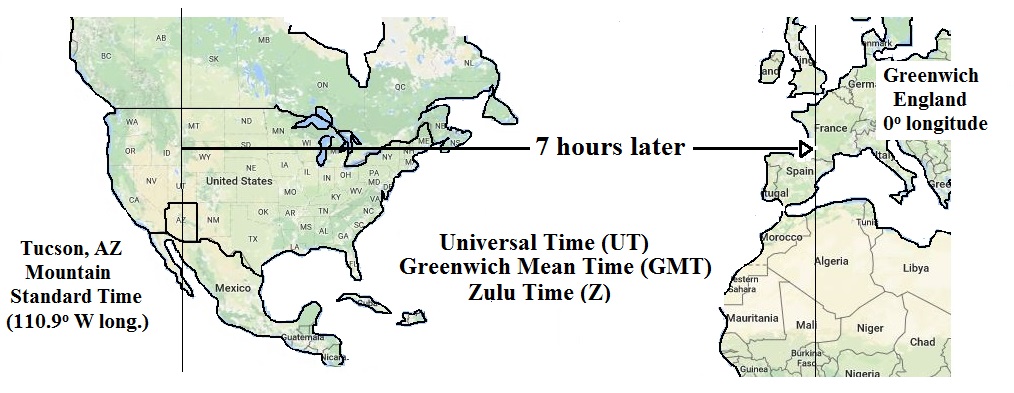
Here are several examples of
conversions between MST and UT (these may differ from the
examples worked in class).
to convert from MST (Mountain Standard Time) to UT
(Universal Time)
10:20 am MST:
add the 7 hour
time zone correction ---> 10:20 + 7:00 = 17:20
UT (5:20 pm in Greenwich)
2:45 pm MST:
first convert to the 24 hour clock by
adding 12 hours ---> 2:45 pm MST + 12:00 = 14:45 MST
then add the 7 hour time zone
correction ---> 14:45 + 7:00 = 21:45 UT (9:45 pm in
Greenwich)
7:45 pm MST:
convert to the 24 hour clock by
adding 12 hours ---> 7:45 pm MST + 12:00 = 19:45
MST
add the 7 hour time zone
correction ---> 19:45 + 7:00 = 26:45 UT
since this is greater than 24:00
(past midnight) we'll subtract 24 hours ---> 26:45
UT - 24:00 = 02:45 UT the next day
to convert from UT (Z)
to MST
15Z:
subtract the 7 hour time
zone correction ---> 15:00 - 7:00 = 8:00 am MST
02Z:
if we subtract
the 7 hour time zone correction we will get a negative
number.
So we will first add 24:00 to 02:00 UT --->
02:00 Z + 24:00 = 26:00 Z
next we will subtract the 7 hour time zone
correction ---> 26:00 - 7:00 = 19:00 MST on the previous
day
2 hours past midnight in Greenwich is 7 pm the previous
day in Tucson



